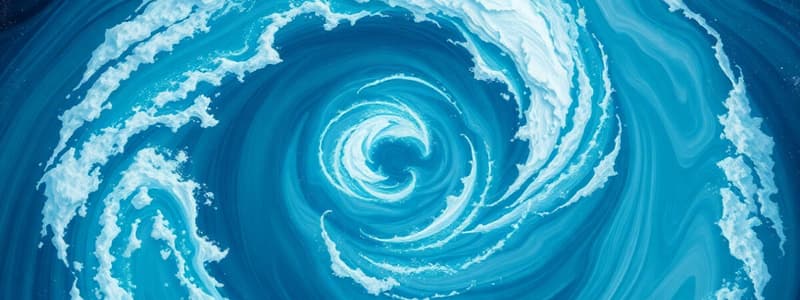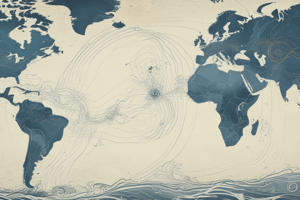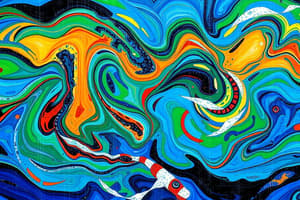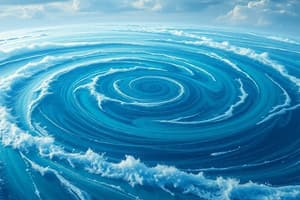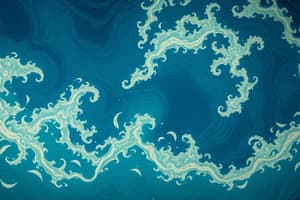Podcast
Questions and Answers
Which of the following global wind belts is characterized by air moving from 30°-60° latitude and curving eastward?
Which of the following global wind belts is characterized by air moving from 30°-60° latitude and curving eastward?
- Westerlies (correct)
- Doldrums
- Trade Winds
- Polar Easterlies
Gyres in the Southern Hemisphere rotate clockwise due to the Coriolis effect.
Gyres in the Southern Hemisphere rotate clockwise due to the Coriolis effect.
False (B)
How does increased evaporation affect the salinity of seawater and why?
How does increased evaporation affect the salinity of seawater and why?
Increased evaporation increases salinity because as water evaporates, salts remain behind, increasing the concentration of salt in the remaining water.
The movement of ocean water driven by differences in temperature and salinity is known as ____________ circulation.
The movement of ocean water driven by differences in temperature and salinity is known as ____________ circulation.
Match the symbiotic relationships with their correct descriptions:
Match the symbiotic relationships with their correct descriptions:
If diatoms at the bottom of a food chain have 925,000 calories of energy, approximately how many calories of energy would be available to squid, assuming they are tertiary consumers?
If diatoms at the bottom of a food chain have 925,000 calories of energy, approximately how many calories of energy would be available to squid, assuming they are tertiary consumers?
Which of the following is NOT a component of HIPPO, an acronym used to summarize major threats to biodiversity?
Which of the following is NOT a component of HIPPO, an acronym used to summarize major threats to biodiversity?
How does excess carbon dioxide ($CO_2$) in the atmosphere primarily impact marine ecosystems?
How does excess carbon dioxide ($CO_2$) in the atmosphere primarily impact marine ecosystems?
Flashcards
Westerlies
Westerlies
Wind belts between 30°-60° N/S that curve eastward due to the Coriolis effect.
Coriolis Effect
Coriolis Effect
The effect of Earth's rotation causing moving air and water to curve.
Ocean Gyres
Ocean Gyres
Large systems of rotating ocean currents.
Nucleosynthesis
Nucleosynthesis
Signup and view all the flashcards
Thermocline
Thermocline
Signup and view all the flashcards
Thermohaline Circulation
Thermohaline Circulation
Signup and view all the flashcards
Upwelling
Upwelling
Signup and view all the flashcards
Mutualism
Mutualism
Signup and view all the flashcards
Study Notes
- Study notes for oceanography review
Global Wind Belts
- Trade Winds (0°-30° N/S) curve westward.
- Westerlies (30°-60° N/S) curve eastward.
- Polar Easterlies (60°-90° N/S) curve westward
- Rising air occurs at the equator (0°) and 60° N/S.
- Sinking air occurs at 30° N/S and 90° N/S.
- Rain clouds form at 0° and 60° N/S.
Coriolis Effect
- Describes how Earth’s rotation causes moving air and water to curve.
- Deflects winds to the right in the Northern Hemisphere.
- Deflects winds to the left in the Southern Hemisphere.
- Influences global wind systems.
Ocean Gyres
- There are 5 major ocean gyres.
- North Atlantic Gyre
- South Atlantic Gyre
- North Pacific Gyre
- South Pacific Gyre
- Indian Ocean Gyre
- Gyres rotate clockwise in the Northern Hemisphere.
- Gyres rotate counterclockwise in the Southern Hemisphere.
- Gyres accumulate trash.
- Plastic debris harms marine life through ingestion, entanglement, and poisoning.
Nucleosynthesis
- The process of forming elements in stars that releases light and heat energy.
- Lighter elements like hydrogen and helium form in regular stars.
- Heavier elements form in supernovae.
Seawater Salinity
- Higher evaporation in summer increases salinity.
- Higher rainfall or freshwater input lowers salinity.
Ocean Profiles and Upwelling
- Upwelling sites bring nutrient-rich cold water to the surface, supporting marine life.
- Thermohaline circulation is the movement of ocean water driven by temperature (thermo) and salinity (haline).
- Cold, salty water sinks, driving deep ocean currents.
Symbiotic Relationships
- Mutualism (+/+)
- Commensalism (+/0)
- Parasitism (+/-)
- Copepods are primary consumers.
- Squid are tertiary consumers.
- Diatoms are producers.
- If the producers have 925,000 calories, the squid would receive 925 calories (10% rule in action: 925,000 → 92,500 → 9,250→925).
- If the shark has 8 calories, the lantern fish would have 8,000 calories (reverse 10% rule: 8 → 80 → 800 → 8,000).
- Most energy is lost as heat through metabolism and cellular respiration.
Threats to Ocean Ecosystems (HIPPO)
- Habitat destruction
- Invasive species
- Pollution
- Population growth
- Overexploitation
Excess CO2
- Causes ocean acidification, harming shell-forming organisms.
- The ocean can only hold so much carbon dioxide until it is re-emitted to the atmosphere, intensifying warming.
- Human CO2 emissions cause rising sea levels that threaten coastal communities.
- Ocean warming disrupts fisheries.
- Eutrophication is excessive nutrient buildup leading to algal blooms and oxygen depletion, suffocating aquatic life.
- In a scenario involving the decline of a primary producer, primary consumer populations would likely increase, and original tertiary consumers would decline due to competition.
- Problems include overfishing, pollution, habitat destruction, and climate change impacts on ocean ecosystems.
Studying That Suits You
Use AI to generate personalized quizzes and flashcards to suit your learning preferences.
Description
Study notes covering global wind belts, the Coriolis Effect, and ocean gyres. Includes the impact of Earth's rotation on wind patterns and the accumulation of trash in gyres, affecting marine life.
